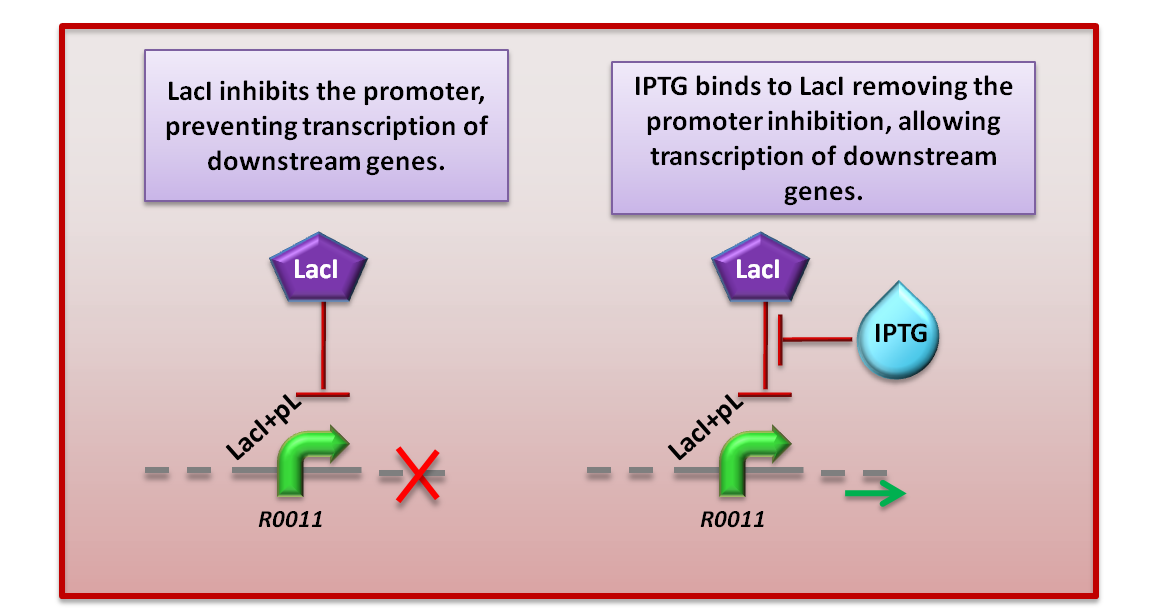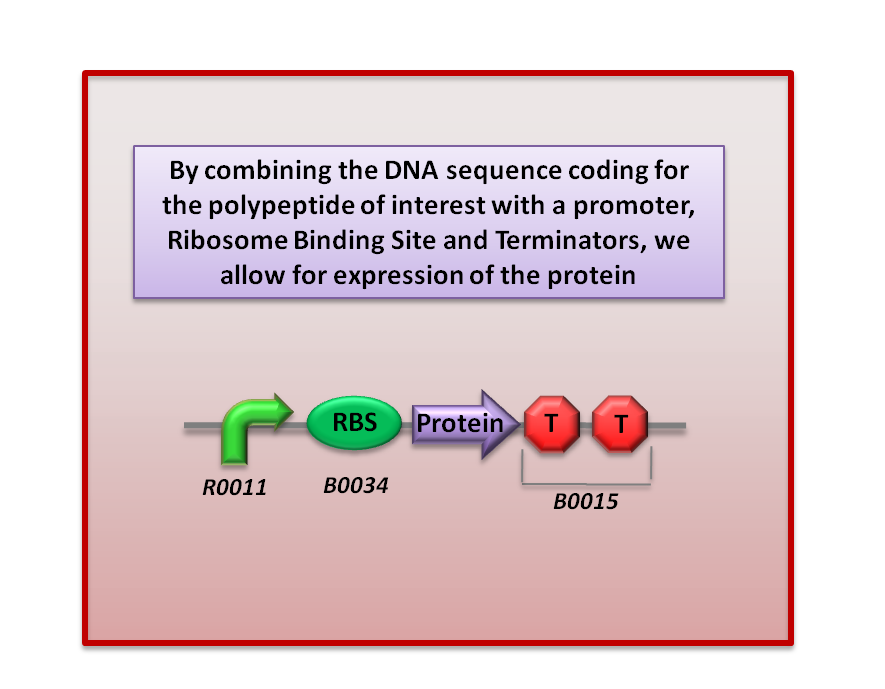Team:Imperial College London/M1
From 2009.igem.org

Contents |
Module 1: Protein Production
Overview
The E.ncapsulator has been designed to produce and deliver polypeptides (amino acid polymers) to the intestine. Here in our system, a single gene is responsible for producing them. In order to perform this function successfuly, the polypeptide must be synthesised at a rate that will be sufficient to facilitate its accumulation inside the cell. Once the optical density of the culture (population of bacteria) has reached an optimal density, polypeptide production is chemically induced using IPTG [ref IPTG induction]. With our generic design, it is possible to synthesise any polypeptide. In our project, we have focused on:
- PAH (phenylalanine hydroxilase): Include an explanation
- Cellulase: Include an explanation
- Opiorphin: Include an explanation
Genetic circuit
 This is the genetic circuit responsible protein drug fabrication (Module 1).
This is the genetic circuit responsible protein drug fabrication (Module 1).
LacI is produced constitutively by the E. coli bacterium, and it represses the pLambda promoter. This inhibits production of the proteins of interest (PAH and cellulase).
To start the drug manufacturing process, IPTG is pipetted into the system. IPTG will repress LacI. As a result, protein production is de-repressed. Then, the enzymes PAH or cellulase will be produced by the E.ncapsulator.
Initiation
The module has been put under the control of an inducible promoter. Under normal circumstances the promoter is repressed by the presence of LacI protein, which stops the RNA polymerase from transcribing [ref]. When IPTG is introduced, it binds to the LacI protein and it changes its conformation, preventing it to bind to the promoter. This lifts the repression [ref here] and allows the downstream genes to be transcribed.
Polypeptide Production
Engineering The E.ncapsulator to produce proteins is quite simple. DNA is transcribed into mRNA which is in turn translated into protein. By knowing the amino acid sequence of the polypeptide of interest and working backwards, this can be converted into a DNA sequence coding for production of the protein. In our case this has been developed further by optimising the DNA sequence for Escherichia Coli. By combining this coding sequence the other necessary genetic components, we engineer the chassis to manufacture the protein.
Polypeptide Showcase
To demonstrate The E.ncapsulator's versatility, we have chosen to showcase it with both enzymes and peptides. These two classes of polypeptide have very different properties that we have considered and catered for in The E.ncapsulator's design.
 About the difference between enzymes and peptides.
About the difference between enzymes and peptides.
Enyzme Production
One of the challenges involved in enyzme production is the need for resistance to the proteases found within the small intestine. Although The E.ncapsulator is capable of delivering the enyzmes safely through the harsh environment in the stomach, upon release into the small intestine, the cells would be susceptible to breakdown by the proteases naturally found in the gut environent. For this reason, we have used protease resistant forms of the enyzmes to be produced.
We have chosen two enzymes to showcase The E.ncapsulator's protein production module.
These are:
- Cellulase - an enzyme that breaks down the tough fibrous molecule cellulose into cellobiose. Cellulose is not digested by the human body and is commonly referred to as dietary fibre. Cellulose is made up of repeating units of glucose molecules, and as such, is a large store of energy. Also, cellulose can form viscous gel-like structures that trap starch, proteins and fats which would otherwise be accessible to the animal's digestive enzymes and transport systems. By using The E.ncapsulator to deliver cellulase to the gut, we hope that more nutritional value can be obtained from food consumed. In doing this we could reduce levels of malnutrition around the world.
- Phenylalanine Hydroxylase - an enzyme that breaks down the amino acid phenylalanine into tyrosine. A deficiency or defective PAH enzyme results in a condition called phenylketonuria. This enzyme deficiency results in the accumulation of phenylalanine in the blood, which can result in serious problems such as seizures and mental retardation. By using The E.ncapsulator's unique drug delivery mechanism, we hope that by delivering PAH into the small intestine, we can relieve people of this condition.
Peptide Production
The delivery and production of short chain peptides is a different challenge altogether. All peptides when synthesised always start with the amino acid methionine. If synthesised directly, this can mean that the peptide no longer has the same bioactivity. The body naturally has a mechanism by which larger polypeptides are degraded into smaller functional peptides. Using this mechanism, we have designed a universal adapter for short chain peptide production and delivery, by which any peptide can be produced and delivered to the gut. To demonstrate this, we have chosen to showcase a short chain peptide, opiorphin:
- Opiorphin - is a small pentapeptide (5 amino acids) that is naturally produced by the body, and plays a role in pain relief and as an anti depressant. By delivering this small peptide into the gut, we hope to offer a natural alternative to the other more addictive drugs.
Module 1 is chemically induced by the addition of IPTG. This makes up part of the temporal control module, under the chemical induction section. After sufficient amount of protein of interest has been produced, autoinduction occurs and encapsulation will start.
Project Tour


 "
"











